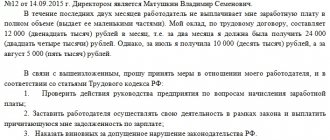A warranty service agreement is a document by which the manufacturer assumes not only confirmation of the quality of the product (service) sold, but also the obligation to eliminate any malfunction that arises during the proper use of the product within the period specified in the contract. Files in .DOC: Warranty service agreement formSample warranty service agreement
Warranty case
Typically, the manufacturer very clearly defines the operating conditions of the products he produces. By signing a warranty service agreement, the buyer simultaneously accepts the operating conditions of the product, that is, certain frameworks beyond which the use of the item will be considered improper.
The framework can be determined by the following indicators:
- maximum network voltage standards;
- extreme temperature conditions;
- maximum vibration standards;
- maximum loads;
- speed limits, etc.;
- maximum permissible mechanical and other impacts on the product. As a rule, according to this criterion, the manufacturer limits the right to warranty repairs in the event of damage to the product by the buyer himself.
If the use of the purchased product does not violate the restrictions established by the manufacturer, then the breakdown will always be considered a warranty case, and the product will be subject to repair.
A non-warranty case will therefore be an unconditional basis for refusal of warranty service.
Sample contract agreement
CONTRACT AGREEMENT No.______
g. ________________ “____”____________ _____ g.
_________________________________ , hereinafter referred to as the Customer , acting on its own behalf, and ______________________________, acting on its own behalf, hereinafter referred to as the Contractor , have entered into an agreement as follows.
Subject of the agreement.
- The Contractor undertakes to perform the following types of work at his own risk:
_____________________________________________________ (hereinafter referred to as “fireplace / stove / barbecue, etc.”) at the Customer’s site at the address: ___________________________________________________________________ _____________________________________________________________________________________________________________________________________.
- The Customer undertakes to accept the result of the work from the Contractor and, if the work is performed properly, to pay for it in accordance with this agreement.
- To perform the specified work, the Customer undertakes to provide the Contractor with the necessary design documentation when signing the contract. The fact that the Contractor has signed the contract means that all the necessary documentation has been transferred to him.
- The Contractor performs the actual installation of the fireplace using materials purchased at the Customer’s expense, using his own equipment and tools, as well as using the Customer’s equipment and tools.
- The start of work is established from ______________________________, the completion of the work and its delivery to the Customer before __________________________ with the right of early completion.
- The work is considered completed after signing the Acceptance Certificate by the Customer or his authorized representative.
- The Contractor is responsible for the property and premises entrusted to him and for any action of his Contractor that entailed loss or damage to the property and premises entrusted to him for the entire period of the Contractor's work.
- The Contractor is responsible for the quality of materials purchased by him at the Customer’s expense.
- Working conditions.
- If, in the process of performing the work, the Contractor made deviations from the design documentation, from the terms of the contract, which worsened the quality of the work, then, at the request of the Customer, he is obliged to correct all identified deficiencies free of charge within the period established by agreement of the parties. Refusal to correct identified deficiencies shall entail penalties for the Contractor in the amount of the cost of work to correct the deficiencies. This cost will be equal to the cost of work to correct defects by a third party (organizations) at the expense of the Contractor.
- If there are significant deficiencies at one of the stages of work, leading to the impossibility of completing all the work in accordance with the requirements of the technical documentation provided by the Customer, the Customer terminates the contract without payment for the work performed by the Contractor.
- The Contractor provides the Customer with reports on the implementation of individual stages of work within the timeframe agreed upon by the parties, as well as intermediate results of the work, to monitor compliance with deadlines and the quality of work performed.
- The Contractor independently organizes all work related to the implementation of this Agreement, determines the direct executors and distributes responsibilities between them. The Contractor is responsible for work performed by third parties as if it were his own.
- Cost of the contract, payment procedure, penalties.
- The cost of this contract is ___________ (amount in words) rubles and consists of the cost of work. In the event of an actual decrease or actual increase in the cost of work, the cost of this contract is adjusted in the appropriate direction: decrease (in the case of an actual decrease) or increase (in the case of an actual increase).
- This amount includes the cost of all work.
- Payment for work is made in the following order:
- Production work ____________
- 50% of the cost of work __________ (amount in words) rub. are paid upon signing the contract.
- 50% of the cost of work __________ (amount in words) rub. are paid upon signing the certificate of completion of work.
- The Contractor transfers the materials remaining after completion of the work to the Customer.
- The contractor independently pays taxes in accordance with the procedure established by law.
- For violation of the agreed deadlines for completing the work and its intermediate stages, the Contractor shall pay a fine in the amount of 0.3% of the amount of the outstanding amount of work under this Agreement for each day of delay.
- For violation of the agreed payment terms, the Customer pays a fine in the amount of 0.3% of the unpaid amount for each day of delay.
- Procedure for terminating the contract.
- The Customer has the right to terminate this agreement unilaterally at any time with payment to the Contractor of monetary remuneration for the work actually performed.
- Guarantee period.
- The warranty period under this agreement is 1 year from the date of signing by the parties of the acceptance certificate. During this period, the Contractor undertakes to correct the identified deficiencies free of charge within 2 weeks from the date the Customer informed him of the identified deficiencies.
- Other provisions.
- The general provisions on contracts (Articles 702 - 729 of the Civil Code of the Russian Federation) apply to this agreement, with the exception of Article 712 of the Civil Code of the Russian Federation.
- The relations under this agreement are not subject to the provisions of the Labor Code of the Russian Federation.
- Disputes under this agreement are resolved by agreement of the parties, and if no agreement is reached, in court.
- This agreement comes into force after it is signed by both parties and is valid until the parties fulfill their obligations in full, unless otherwise provided by this Agreement.
- Attachments to the contract.
- Attached to the agreement:
- Fireplace project
- Estimate for work and materials.
- Proposals about the Contractor's intentions.
- Addresses and details of the parties:
Contractor: (passport details)
________________________________________________________________________________________________________________________________________________________________________________________________________________________
Customer: (passport details)
________________________________________________________________________________________________________________________________________________________________________________________________________________________
Signatures of the parties:
Contractor: ___________________________ (full name)
Customer: ___________________________ (full name)
Contents of the agreement
Warranty service is always a contract of adhesion. That is, under the terms of the contract, the buyer either accepts the terms of warranty service developed by the manufacturer or refuses to purchase the product.
This means that the manufacturer himself determines the characteristics of a warranty case, the period and place of warranty service, and the buyer cannot set any conditions.
This explains the fact that most often a warranty service agreement in the form in which the agreement is commonly understood is not concluded at all. Instead of a contract, the seller issues a book or warranty service coupon with the necessary information integrated into it. In this case, both are considered equivalent to a concluded contract.
Regardless of how the warranty legal relationship is drawn up - a book, a coupon or an agreement, in any case they must include all the essential terms of the agreement, namely:
- date and place of purchase of the goods;
- manufacturer's name and seller's name;
- name (full name) of the buyer;
- name of the purchased product (service), its technical characteristics, serial number, other information that allows you to identify the product;
- a description of the operating limits in accordance with the instructions or simply a link to the instructions. In this case, the buyer’s signature is taken indicating that he is familiar with the rules for using the product. In practice, the seller, as a rule, simply shows the buyer exactly where and how many times to sign;
- the term of the contract, that is, the time period during which the manufacturer’s guarantee on the quality of the item will be valid;
- the procedure for transferring an item for warranty repair;
- the procedure for conducting an inspection or examination of a thing to establish a warranty case;
- conditions for warranty repairs. Conditions for repairs at home, in a specialized workshop or at the location of the manufacturer can be discussed;
- conditions for replacing items of inadequate quality if warranty repairs are impossible;
- conditions for refusal of warranty repairs;
- liability of the parties to the contract, including penalties for failure to fulfill the terms of the contract;
- details and signatures.

A warranty card, warranty book or classic warranty service agreement is handed over to the buyer and is subsequently used in the event of warranty cases.
Warranty periods for services established by law
It is quite logical that when you buy a product or enter into an agreement for the provision of services, your intention is to use the purchased benefit for a certain time.
To ensure proper operation of the product or the quality of the services provided (work performed), the manufacturer (supplier, seller, contractor, etc.) determines the period during which you, if you find a defect in the product offered by him, can demand a refund or exchange of goods or its free repair. This period is called the warranty period.
Of course, the longer the warranty period provided, the more attractive the product/service, because it is clear to the buyer that the manufacturer is confident in the quality of its product, and in the event of a breakdown, it will not leave the client alone with the problem.
Conversely, a product without an expiration date usually does not inspire confidence.
As follows from the provisions of the current legislation, determining the warranty period is not an obligation, but a right that consistently arises:
- From the manufacturer.
- If the manufacturer refuses to establish the warranty period, contact the seller.
- If the latter does not want to set a period, the legal norm is in force, according to which the period is 2 years and begins to be calculated from the moment the goods are transferred for use to the consumer or, if it is impossible to establish this moment, from the date of manufacture of the product.
It is clear that it is impossible to establish a warranty period for an intangible service - for example, for a specialist consultation provided orally. However, the contract itself for the provision of such a service can and should be concluded.
Other services that result in some kind of material embodiment, like other goods offered on the market, must have a warranty period. This is quite fair, since the purchaser pays money for the service provided and, therefore, can count on the fact that it is not wasted.
The warranty period when concluding a purchase and sale agreement must be determined by the parties entering into the agreement, however, in some cases such terms are established at the legislative level.
Please note: the legislator determines only the minimum warranty period. The parties to the transaction have the right, by mutual agreement, to establish a longer duration of this period.
At the end of the warranty period, unless otherwise specified, the manufacturer/seller is released from previous obligations.
The warranty on work performed ranges from 1-3 years, depending on the type of service.What does the warranty cover?
The guarantee applies to all work carried out by us, and also applies to rough materials supplied by us.
agreement here
Agreement No. _
Minsk 2012
1. IP Voryakin, hereinafter referred to as the “Contractor”, on the one hand, and, hereinafter referred to as the “Customer”, represented by the director of the current
on the basis of the Charter, on the other hand, we have concluded this Agreement on the following:
1. Subject of the agreement
1.1. The Customer instructs, and the Contractor undertakes to carry out the work:_______________________________________________________________________________
1.2. The Customer undertakes to create the necessary conditions for the Contractor to perform the work, accept their results and pay for the work performed by the Contractor,
specified in clause 2.1 of this Agreement.
2. Cost of work and payment procedure
2.1. The cost of work under this Agreement is determined in the Cost Estimate (Appendix No. 1) and includes VAT 20%
2.2. The customer makes payment in the following order:
no later than 5 working days from the date of signing this agreement;
within no later than 5 working days from the moment the parties sign the Work Acceptance Certificate.
2.3. The work is considered completed by the Contractor and accepted by the Customer for payment after the Parties sign the Work Acceptance Certificate.
Delivery and acceptance of the work result (work stage) is formalized by a bilateral Certificate of Completion of Work within 3 days
from the moment of written notification by the Contractor to the Customer about the completion of the work performed.
2.3. If the Customer discovers deficiencies in the Contractor's work, they are reflected in the Certificate with a list of necessary improvements and deadlines for completion.
2.4. Payment for the work is made by transferring funds by the Customer to the bank account
The Contractor within 5 working days from the date of signing by the parties of the Acceptance Certificate for the completed work,
confirming that the Contractor has completed the work in full.
3. Obligations of the parties
3.1. Responsibility for compliance with safety regulations, including personal ones, during work in accordance with clause 1.1 of this
The Contract is assigned to the Contractor.
3.2. The Contractor undertakes to perform the work with proper quality, using his own materials and tools.
3.3. The Contractor undertakes to complete the work within the time period specified in clause 5.1 of this Agreement.
3.4. The Contractor undertakes a warranty obligation for the quality of the work performed for 24 (twenty-four) months
from the moment of signing the Work Acceptance Certificate.
3.5. The Contractor ensures that the area is fenced in compliance with safety regulations.
3.6. The Customer provides the Contractor with a room for a changing room and storage of equipment, tools, etc.
3.7. The customer ensures that there are no foreign objects in the work area.
3.8. The Customer appoints a responsible person to coordinate actions with the Contractor.
3.9. The Customer undertakes to accept the Contractor's work within 3 days from the date of receipt of the Contractor's written notification.
3.10 The Contractor undertakes to begin work within 5 (five) working days after receiving the advance payment.
4. Responsibility of the parties and procedure for resolving disputes
4.1. If the Contractor does not fulfill its obligations in accordance with clause 1.1 of this Agreement,
then the Contractor undertakes to complete the specified work in full and pay
The customer will receive a penalty in the amount of 0.1% of the cost of uncompleted work hereunder
Agreement for each day of delay, but not more than 20% of the cost of work under this Agreement.
4.2. If the Customer fails to fulfill his obligations regarding the terms of payment for the work performed provided for in this Agreement,
then the Customer undertakes to pay the Contractor a penalty in the amount of 0.1% of the amount of non-payment for each day of delay,
but not more than 20% of the cost of work under this Agreement.
4.3. Disputes and disagreements that may arise during the execution of this Agreement are resolved through negotiations between the Parties.
5. Deadline for completing the work.
5.1. The period for completion of work under this Agreement is set at 2012.
5. Final provisions
6.1. This Agreement comes into legal force from the moment/date of its signing by the Parties and is valid until the Parties fully fulfill their obligations.
6.2. All changes and additions to the Agreement are an integral part of it and have legal force if they
drawn up in writing and signed by authorized representatives of the Parties.
6.3. This Agreement is drawn up in 2 copies having equal legal force - one for each Party.
6. Addresses and bank details of the parties:
CUSTOMER:
CONTRACTOR:
Warranty obligations for products. Certificates
The supplier's obligation to eliminate defects or replace goods arises upon receipt of a corresponding request. From this we can conclude that for contracts concluded before June 1, the deadline for fulfilling obligations was previously determined differently. In cases where the period for eliminating defects or replacing the goods was not agreed upon, the supplier had to fulfill the corresponding requirement within a reasonable time, Art. Such demands are allowed to be made for 2 years from the date of receipt of the product by the buyer. There is a group of goods that, by law, can be disputed after the established deadline.
from the manufacturer, the taxpayer has the right.
How to register a warranty from the manufacturer
The warranty for the Product is provided by the manufacturer and the Supplier. The warranty period of the product corresponds to the manufacturer's warranty. On average, the product warranty is 12 months 1 year from the date of transfer of the Product to the Buyer. Warranty repairs are provided in the presence of a warranty card; in case of its loss, the function of the warranty card is performed by the delivery note. Warranty repairs of equipment that has failed are carried out free of charge during the entire warranty period if, during inspection and diagnostics of the equipment, it is determined that this is a warranty case. The warranty does not apply to consumables, as well as to parts and components designated by the manufacturer as not subject to warranty repair or replacement, for example, covers, knives, filters, seals, heating elements, backlights, glass, painting, etc. If repairing large equipment is impossible on site, then repair of warranty equipment is carried out in service centers. Desktop equipment is not repaired on site, but rather transported to service centers. In this case, the delivery of equipment to the repair site and back is carried out by the client independently and at his own expense. In the event of a warranty claim occurring outside of











